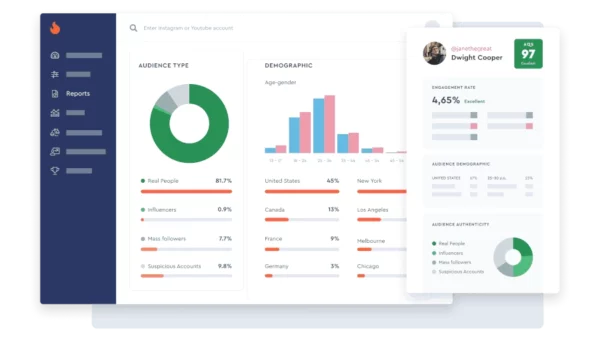March 15, 2022
How to Create an Awesome Influencer Media Kit (Quick & Easy)

We all know that influencer marketing is on the rise. In fact, it has become so popular that every person who has a decent follower base thinks they can become an influencer.
And the trend of hiring nano influencers (<1000 followers) has further fueled this.
But how can you let the brands know that you’re a legit, professional influencer and not some amateur? That’s where an influencer media kit comes into the picture.
An influencer media kit is your digital portfolio as an influencer. It tells the brands all the important information about you that they need before hiring you.
You can use your influencer media kit to showcase your past, successful brand collaborations. Or you can tell brands about what makes you different from other influencers. You can also include your social media statistics in your influencer media kit to build your credibility.
There are a lot of things that can be included in an influencer media kit. In this post, I have listed some of the essential things that you need in your influencer media kit to make a good impression on brands.
So, read on, and find out everything that you need to create an awesome influencer media kit.
Introduction
The first thing that you should include in your influencer media kit is a short introduction about yourself. Before you start divulging statistics and other information, you need to first let them know who you are.
Make your introduction short and snappy and think of it as your elevator pitch. You need to gain brands’ interest and sell yourself without expecting them to spend too much time reading about you.
You can tell them about your background and why you chose to be an influencer. Also mention your interests, personal values, and your area of expertise.
These things will help brands understand your personality and see if it fits with the influencer persona that they have in mind.
Social media account statistics
This is probably the first thing that brands look for while conducting their influencer research. They need to know whether you have enough reach and engagement to actually help their business grow.
You can include metrics like the number of followers, average likes and comments per post, and the frequency at which you post. These details will give brands an idea about your posts’ reach and engagement rates, which are important parameters for influencer selection.
These are some metrics that all brands look at before hiring an influencer and should be included in your influencer media kit.
If you are active on multiple social media platforms, you should provide these numbers for all your social media accounts.
Audience demographics
Once the brands believe that you have a substantial reach and engagement, the next thing they will want to know is whether your audience is relevant to them. After all, they want to hire you to reach your audience.
So, it is imperative that you include your audience demographics in your influencer media kit. Some key things to include are age, gender, location, and interests. You can even share the audience personas defining your followers.
You can also use tools like HypeAuditor, which provides detailed audience demographics reports. It includes not just demographics, but also audience interests, which is an important metric for brands.
Following is a sample report for Dwight Cooper’s audience demographics:

By providing these metrics to brands, you can help them understand whether your audience matches their target customer segment or not.
Successful Brand Collaborations
This is a must-have section in any influencer media kit. Just like a writer needs to show their previous writing samples and photographers show past campaign pictures, influencers need to show past collaborations.
In this section, you can mention the brands that you have worked with, the types of content you produced, and the results that you achieved. If you can show some analytics reports of your past campaigns’ performance then that’s an added advantage.
Showing your past successes can help you seem more trustworthy and prove that you’re worthy of the time and money that they will invest in partnering with you.
What if you are new to the field and have not collaborated with any brands yet? Then you can mention the types of collaborations that you are up for in your media kit.
Some common types of brand-influencer collaborations include:
- Sponsored posts
- Hosting or promoting giveaways and contests
- Display ads on blog posts
- Sponsored blog posts
- Product reviews
- Affiliate marketing
Give as many specifics as you can about what you can offer them and how you can promote their brand or products.
Client testimonials
In addition to mentioning your past brand collaborations, it is always a good idea to provide client testimonials in your influencer media kit.
Reading positive testimonials from other brands that have worked with you will instill confidence in other brands to work with you. It provides social proof that if others have done it then they should too.
Brands go through numerous influencer profiles before they select one. And testimonials are a sure-shot way to stand out in the crowd.
However, show testimonials if you genuinely have some, otherwise, don’t. Do not try to fake it or show inauthentic testimonials. If your potential clients find it out, it will do much more harm than good.
Pricing
This is one of the most important elements in any business transaction and is an important factor that brands consider while finding influencers. Providing clear and specific pricing for each type of collaboration will help make the negotiation process go faster and smoother.
Brands will know exactly what to expect as you have already specified your expectations.
Also, while setting the prices, do remember to leave some room for negotiation. If you are too adamant on your set prices, people might think you’re not flexible and might avoid working with you.
So, think of your rate card as a baseline for price negotiation, but don’t be too rigid when it comes to pricing.
And if you are a relatively new influencer, you might even tell brands that you’re open to the option of getting paid in kind. It can be a free product in exchange for a product review. Or it can be discounted services for a brand mention. The payment should obviously be according to the type of collaboration. But you should, at least, mention that you’re open for such options.
Contact information
Last, but not least, is your contact information. This is an important piece of information to include in your influencer media kit because this is how brands will reach out to you.
You should provide your email address and phone number. You can also mention specific times when you are available to take a call. In cases where brands might need to send product samples, you can also include your complete postal address.
Also, don’t forget to include links to all of your social media accounts so that brands can check them out.
Conclusion
An influencer media kit is a must-have for any influencer who is serious about taking this professionally. This is something that provides you the chance to showcase your expertise and stand out in the crowd.
These expert tips will help you make an awesome media kit that will encourage brands to pick you over others.
So, what are you waiting for? Start creating your influencer media kit right now.
